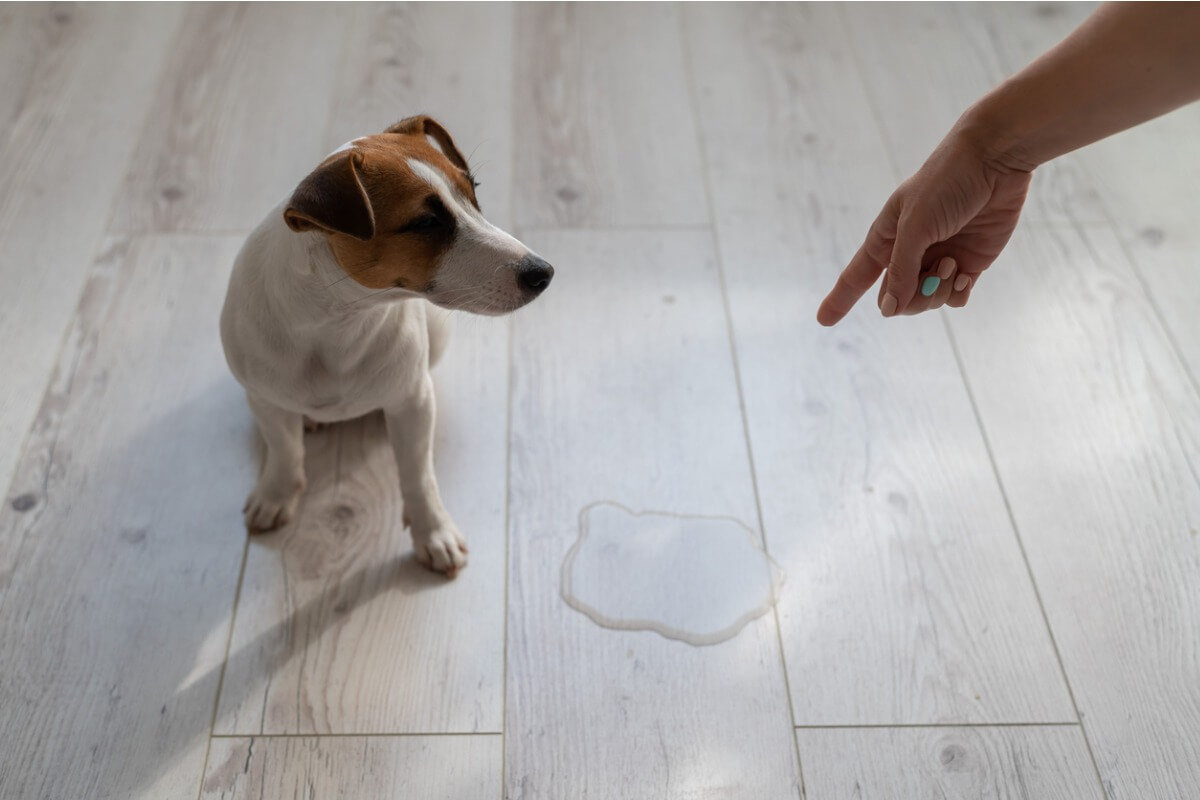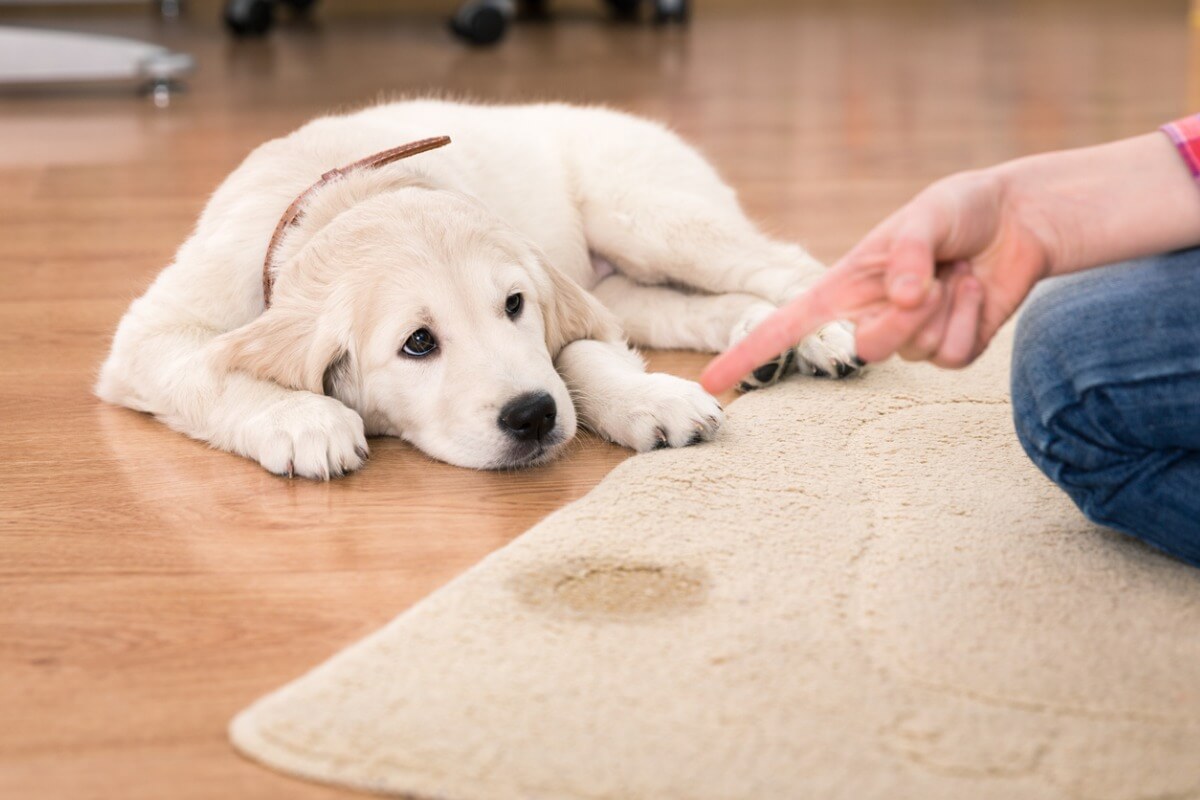The Best Dog Urine Repellents


Reviewed and approved by the biologist Samuel Sanchez
The use of dog urine repellents helps to prevent a dog from urinating and doing “number twos” wherever you apply them. You’ll need to start using them if your dog doesn’t do their “business” in the areas you’ve provided for it, either by mistake or because they are in the process of training, as in the case of puppies.
Similarly, these products are very useful to prevent other dogs from urinating at the entrance to your house or garden. You’ll be able to keep them away and prevent your dogs from responding to this marking behavior by urinating in the same place. In this article, we’ll tell you what options you have to avoid the typical marking custom of this species – most of them are totally natural.
Tips for your dog repellent
Before applying the dog urine repellents, you’ll need to clean the area where you’re going to apply them very well. We’re not talking about a normal cleaning here, as you’ll need to use gloves and masks to collect the waste.
After that, you should clean the area with enzymatic products, which are environmentally friendly. They dissolve and degrade different chemical and natural waste substances, including those present in hard-to-reach areas. It’s best to avoid bleach or ammonia, as their odor reinforces the pet’s marking behavior.
If your dog has urinated on curtains or carpets, make sure you don’t rub the area with absorbent towels or kitchen paper. The best thing to do is to simply place them over the mess and let them absorb the liquid. Otherwise, you’ll only spread the urine on unaffected areas. After drying the urine, wash the textiles.
If the affected area is covered with feces, use toilet paper and a biodegradable bag or towel to collect them. Use a towel soaked in water with the enzymatic product you bought or with neutral soap and wipe off the remains. Once everything is clean, apply the repellent.

The benefits of natural repellents
There are different types of dog urine repellents on the market. Some of the most notable ones are those of natural origin, which have certain benefits when compared to chemical products. These repellents are usually made with ingredients that have unpleasant odors for dogs, without being of any danger to them.
However, we must prioritize repellents that work well in keeping your dog away from the area, but which won’t trigger any allergies in them. Among the available options are repellents made with cayenne pepper, lemon, white vinegar, or aromatic plants such as citronella.
Lemon: the best repellent for dogs
Repellents for dog urine made with lemon are considered the best of all. As studies show, a dog’s sense of smell is 10,000 times more sensitive than a human’s, and the smell of this fruit is very unpleasant for them.
It’s safe to use, and can be used inside the house to prevent your dog from doing their “business” in areas that they shouldn’t. There are products on the market whose active ingredient is lemon, but you can also make one at home. All you need is the following:
- Lemons
- Water
- Baking soda
Squeeze as many lemons as you need to get 100 milliliters of juice, mix it with 50 milliliters of water, and then add a tablespoon of baking soda. Shake or stir it well and put it in a spray bottle and apply it to the area. Repeat as many times as necessary until the dog no longer goes to the toilet in that area.
Oranges, tangerines, and citrus fruits
Dog urine repellents can also be made from oranges, tangerines, limes, or grapefruit. However, in the case of sweet citrus fruits, the surfaces you apply them to may become somewhat sticky due to the glucose present in them, which is a type of sugar.
White vinegar dog urine repellent
White vinegar is a product that most people have at home. It’s used to dress salads and some culinary preparations. It’s also used in cleaning processes, as it has disinfectant properties. It has a strong smell and is, therefore, also used in the development of repellents for dogs.
As with lemon, the smell of vinegar is too strong for the dog, and so they stay away when they smell it. If you want to make a homemade repellent with this liquid, these are the ingredients you should use:
- Hot water
- White vinegar
All you need to do is mix the hot water with the vinegar in a spray bottle. Then spray the affected area and let it act for 30 minutes. You can use it whenever you consider it necessary.
Dog repellent with alcohol
Using antiseptic alcohol as a dog urine repellent is another option we have for you. Alcohol has outstanding antibacterial properties, and so it’s typically used to disinfect wounds and surfaces.
Its smell is quite strong and will scare your dog away. To use it in this way, all you need to do is mix it with water and apply it using a sprayer. It’s recommended that you keep an eye on the dog to ensure it doesn’t lick the mixture, as alcohol can cause diarrhea and digestive problems.
Repellents for dogs on sofas
When a dog does its needs on the couch, it’s more difficult to eliminate the smell and prevent a repeat of this behavior. The success lies in a proper cleaning process, in which you must use enzymatic products that destroy the odor in the innermost fibers of the item of furniture. After that, use a strong repellent.
Cayenne pepper
Cayenne pepper is a good “active ingredient” for making homemade dog repellents. Not only does it prevent dogs from relieving themselves on sofas, but it also prevents them from chewing on furniture. It’s an ingredient that should be used sparingly, as it irritates the dog’s mucous membranes. There are two ways to use it: in powder and liquid form.
The first way of application is simple, as it consists of sprinkling a little ground pepper on the affected area. The second requires mixing the powder with a little water in a spray bottle, with this being the less invasive option.
Hydrogen peroxide
Hydrogen peroxide is very useful when cleaning fabric surfaces, as it effectively cleans and eliminates odors, such as urine and dog feces.
This compound doesn’t have a strong odor for humans, but it does for dogs. So, in addition to cleaning very well, it scares dogs away, preventing them from going back to relieve themselves where they shouldn’t.
To use this compound, you’ll need to mix it with water in a spray bottle and have a second spray bottle with just water. Firstly, spray the mixture with hydrogen peroxide, let it act for 30 minutes and then rinse with the water-only sprayer.
Repellents not recommended for dogs
Although the market offers countless repellents for dog urine, beware of those that contain harmful chemicals. We’ll mention them below:
- Naphthalene: This is a toxic component that can be fatal for dogs.
- Ammonia and chlorine: Both are irritating to dogs and humans and have an odor similar to urine, so they won’t scare away dogs.
- Chili: This irritates the mucous membranes of dogs due to its high concentration of capsaicinoids, compounds that give this ingredient its spiciness.

How to prevent your dog from urinating or defecating in your house
If your dogs urinate or defecate constantly inside the house, you’ll need to go further than the use of repellents. You’ll need to find the reason why the dogs don’t wait to go out or are not using the designated space in the house. In some cases, this behavior is related to stress, urinary diseases, and self-control problems.
Depending on the severity of the problem, you may need to seek veterinary help or consult an ethologist (behaviorist). This expert won’t only be able to help you when it comes to behavioral problems, but will also give you useful training guidelines to eradicate the behavior.
The use of dog urine repellents helps to prevent a dog from urinating and doing “number twos” wherever you apply them. You’ll need to start using them if your dog doesn’t do their “business” in the areas you’ve provided for it, either by mistake or because they are in the process of training, as in the case of puppies.
Similarly, these products are very useful to prevent other dogs from urinating at the entrance to your house or garden. You’ll be able to keep them away and prevent your dogs from responding to this marking behavior by urinating in the same place. In this article, we’ll tell you what options you have to avoid the typical marking custom of this species – most of them are totally natural.
Tips for your dog repellent
Before applying the dog urine repellents, you’ll need to clean the area where you’re going to apply them very well. We’re not talking about a normal cleaning here, as you’ll need to use gloves and masks to collect the waste.
After that, you should clean the area with enzymatic products, which are environmentally friendly. They dissolve and degrade different chemical and natural waste substances, including those present in hard-to-reach areas. It’s best to avoid bleach or ammonia, as their odor reinforces the pet’s marking behavior.
If your dog has urinated on curtains or carpets, make sure you don’t rub the area with absorbent towels or kitchen paper. The best thing to do is to simply place them over the mess and let them absorb the liquid. Otherwise, you’ll only spread the urine on unaffected areas. After drying the urine, wash the textiles.
If the affected area is covered with feces, use toilet paper and a biodegradable bag or towel to collect them. Use a towel soaked in water with the enzymatic product you bought or with neutral soap and wipe off the remains. Once everything is clean, apply the repellent.

The benefits of natural repellents
There are different types of dog urine repellents on the market. Some of the most notable ones are those of natural origin, which have certain benefits when compared to chemical products. These repellents are usually made with ingredients that have unpleasant odors for dogs, without being of any danger to them.
However, we must prioritize repellents that work well in keeping your dog away from the area, but which won’t trigger any allergies in them. Among the available options are repellents made with cayenne pepper, lemon, white vinegar, or aromatic plants such as citronella.
Lemon: the best repellent for dogs
Repellents for dog urine made with lemon are considered the best of all. As studies show, a dog’s sense of smell is 10,000 times more sensitive than a human’s, and the smell of this fruit is very unpleasant for them.
It’s safe to use, and can be used inside the house to prevent your dog from doing their “business” in areas that they shouldn’t. There are products on the market whose active ingredient is lemon, but you can also make one at home. All you need is the following:
- Lemons
- Water
- Baking soda
Squeeze as many lemons as you need to get 100 milliliters of juice, mix it with 50 milliliters of water, and then add a tablespoon of baking soda. Shake or stir it well and put it in a spray bottle and apply it to the area. Repeat as many times as necessary until the dog no longer goes to the toilet in that area.
Oranges, tangerines, and citrus fruits
Dog urine repellents can also be made from oranges, tangerines, limes, or grapefruit. However, in the case of sweet citrus fruits, the surfaces you apply them to may become somewhat sticky due to the glucose present in them, which is a type of sugar.
White vinegar dog urine repellent
White vinegar is a product that most people have at home. It’s used to dress salads and some culinary preparations. It’s also used in cleaning processes, as it has disinfectant properties. It has a strong smell and is, therefore, also used in the development of repellents for dogs.
As with lemon, the smell of vinegar is too strong for the dog, and so they stay away when they smell it. If you want to make a homemade repellent with this liquid, these are the ingredients you should use:
- Hot water
- White vinegar
All you need to do is mix the hot water with the vinegar in a spray bottle. Then spray the affected area and let it act for 30 minutes. You can use it whenever you consider it necessary.
Dog repellent with alcohol
Using antiseptic alcohol as a dog urine repellent is another option we have for you. Alcohol has outstanding antibacterial properties, and so it’s typically used to disinfect wounds and surfaces.
Its smell is quite strong and will scare your dog away. To use it in this way, all you need to do is mix it with water and apply it using a sprayer. It’s recommended that you keep an eye on the dog to ensure it doesn’t lick the mixture, as alcohol can cause diarrhea and digestive problems.
Repellents for dogs on sofas
When a dog does its needs on the couch, it’s more difficult to eliminate the smell and prevent a repeat of this behavior. The success lies in a proper cleaning process, in which you must use enzymatic products that destroy the odor in the innermost fibers of the item of furniture. After that, use a strong repellent.
Cayenne pepper
Cayenne pepper is a good “active ingredient” for making homemade dog repellents. Not only does it prevent dogs from relieving themselves on sofas, but it also prevents them from chewing on furniture. It’s an ingredient that should be used sparingly, as it irritates the dog’s mucous membranes. There are two ways to use it: in powder and liquid form.
The first way of application is simple, as it consists of sprinkling a little ground pepper on the affected area. The second requires mixing the powder with a little water in a spray bottle, with this being the less invasive option.
Hydrogen peroxide
Hydrogen peroxide is very useful when cleaning fabric surfaces, as it effectively cleans and eliminates odors, such as urine and dog feces.
This compound doesn’t have a strong odor for humans, but it does for dogs. So, in addition to cleaning very well, it scares dogs away, preventing them from going back to relieve themselves where they shouldn’t.
To use this compound, you’ll need to mix it with water in a spray bottle and have a second spray bottle with just water. Firstly, spray the mixture with hydrogen peroxide, let it act for 30 minutes and then rinse with the water-only sprayer.
Repellents not recommended for dogs
Although the market offers countless repellents for dog urine, beware of those that contain harmful chemicals. We’ll mention them below:
- Naphthalene: This is a toxic component that can be fatal for dogs.
- Ammonia and chlorine: Both are irritating to dogs and humans and have an odor similar to urine, so they won’t scare away dogs.
- Chili: This irritates the mucous membranes of dogs due to its high concentration of capsaicinoids, compounds that give this ingredient its spiciness.

How to prevent your dog from urinating or defecating in your house
If your dogs urinate or defecate constantly inside the house, you’ll need to go further than the use of repellents. You’ll need to find the reason why the dogs don’t wait to go out or are not using the designated space in the house. In some cases, this behavior is related to stress, urinary diseases, and self-control problems.
Depending on the severity of the problem, you may need to seek veterinary help or consult an ethologist (behaviorist). This expert won’t only be able to help you when it comes to behavioral problems, but will also give you useful training guidelines to eradicate the behavior.
All cited sources were thoroughly reviewed by our team to ensure their quality, reliability, currency, and validity. The bibliography of this article was considered reliable and of academic or scientific accuracy.
- Castellví Guimerá JL. La eficacia en la detección canina en el ámbito de las fuerzas armadas: Propuesta de un estándar de evaluación. Sanid. mil. 2019; 75 (1): 98-101, ISSN: 1887-8571
This text is provided for informational purposes only and does not replace consultation with a professional. If in doubt, consult your specialist.








